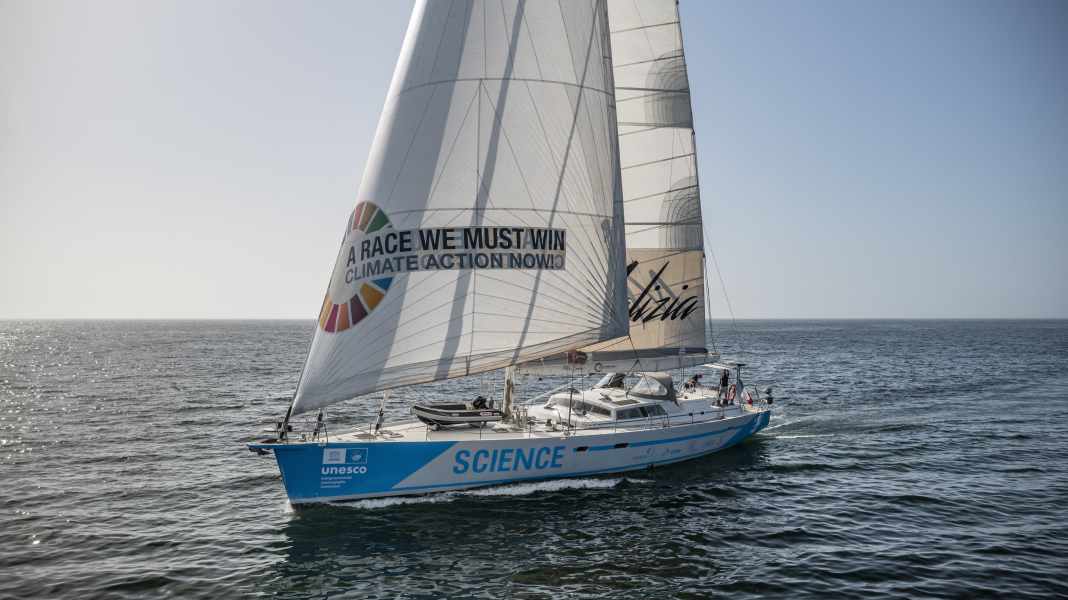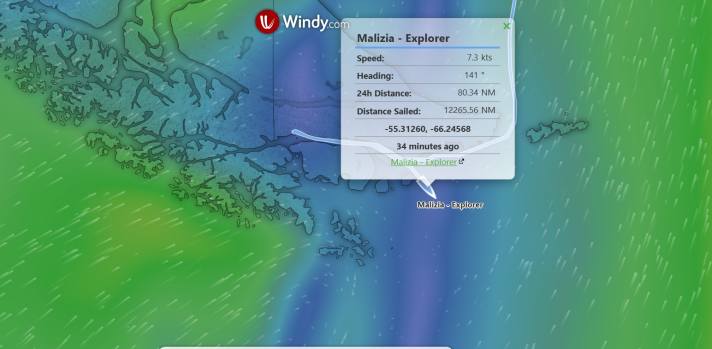
Ushuaia, the southernmost major city in the world, is the starting point for this extraordinary research adventure. A 14-strong team is setting off for Antarctica on the 26-metre-long "Malizia Explorer". Unlike typical Antarctic expeditions, which are carried out on large ships, the team led by ocean racing sailor Boris Herrmann is using a robust sailing boat. Their destination is the Danger Islands - a remote archipelago of seven small islands that only became the focus of research six years ago when scientists discovered the world's largest colony of Adelie penguins there: over one million breeding pairs on just five square kilometres. The expedition brings together scientists, sailors and journalists who want to explore this unspoilt wilderness together.
The "Malizia Explorer": a robust research sailboat instead of a racing Imoca
26 metres long, almost 7 metres wide, more than 60 tonnes of aluminium: the "Malizia Explorer" is impressive for its dimensions alone. The Garcia 85, originally built in 2005 as the "Beniguet" and later used as the luxury charter "Fani", was taken over by Boris Herrmann and his team in Lorient in spring 2025. The ship has a 36 metre high mast and a 19 tonne hydraulically operated keel. In contrast to the racing Imoca, the "Malizia Explorer" is designed for robustness, independence and long research trips to remote regions.
Boris Herrmann sees the ship as a logical development of his team's "Climate Action Now" mission. It is intended to help broaden the scope and spread the message about marine conservation and climate change. "I've been campaigning for this for a long time. If you don't try, you don't win. We want to show that you can make meaningful contributions to research with a sailing yacht - especially in places where large ships can't go," says Herrmann, explaining the motivation behind the project. He is supported by Pierre Casiraghi and Prince Albert II of Monaco, who have been committed to protecting the oceans for years.
The ship is equipped with state-of-the-art technology, including an OceanPack laboratory for recording oceanographic data such as salinity, temperature and CO2 content. The spacious saloon was completely remodelled for the expedition and is full of scientific equipment, computers and chargers. All 14 beds in the five cabins are occupied - seven scientists, four sailors and three journalists share the limited space on board.
YACHT author Andreas Lindlahr accompanied the Malizia Explorer on its journey from Almerimar via Senegal to South America. In YACHT 01/2026 (on newsstands from 10 December), he describes the special journey on a special boat.
The challenges of travelling to Antarctica
Before the research work on the islands can begin, the team has to cross the notorious Drake Passage - one of the stormiest sea areas in the world. Boris Herrmann has hired an experienced Antarctic sailor for the challenging voyage: Argentinian Lucas Lanusse. On the electronic weather chart at the navigation table, the skipper shows the dark red zones that quickly pass between Cape Horn and the Antarctic Peninsula and indicate violent storms. "You should set off when a low-pressure area leaves and try to cross the passage before the next one approaches," explains Lanusse in a film report by ZDF the strategy for the crossing. Even for the experienced sailor, this expedition is not like any other trip: "Sailing to the Danger Islands is the biggest challenge of my life. I'm really looking forward to it, but it will be tough for all of us." The trip can be tracked in the tracker.

Germany's first protected area in the Antarctic
The Danger Islands are of particular importance to German environmental protection. In 2024, they were designated as the first German protected area in the Antarctic. "We worked on this for five years," says Fritz Hertel from the Federal Environment Agency. As a member of the polar team, he is responsible for authorising German expeditions and tourist activities in Antarctica. The agency even had to review its own mission, as access to the Danger Islands is only permitted with a special permit. "Now we can finally see and experience the area for ourselves, which we have previously explored from afar from our desks," explains Hertel. Germany has committed to regularly monitoring the area, as the penguins are considered important indicators of the state of the Antarctic ecosystem and their population development reveals a lot about the effects of climate change.
Scientific objectives of the expedition
The expedition is a joint project between Team Malizia, the Alfred Wegener Institute for Polar and Marine Research (AWI), the Thuringian Institute for Sustainability and Climate Protection (ThINK) and the Federal Environment Agency (UBA). As the initiator of the protected area, Germany is now responsible for its management. The current expedition is part of this commitment and is intended to provide scientific findings that can be directly translated into political measures. The Danger Islands are considered a virtually untouched area and represent a valuable scientific reference point, especially in view of the rapid climate changes in the region.
The scientific programme of the expedition covers various areas of research. The "The islands are untouched wilderness," says Osama Mustafa from the Thuringian Institute for Sustainability and Climate Protection. The polar expert from Jena is leading the scientific team and has clear ideas about the research objectives: "Our main goal is to preserve the huge penguin colony." To achieve this goal, the team wants to use drones to count the animals and collect rock samples. At the same time, bird expert Simeon Lisovski from the Alfred Wegener Institute plans to take blood samples from the penguins to analyse them for diseases such as bird flu. The scientists want to use the data to gain a better understanding of the fragile ecosystem and develop protective measures. The research results should also help to strengthen the protected status of the islands and possibly extend it to the surrounding marine areas.
Safety has top priority
The Danger Islands are not only a challenge because of the difficult journey. There are hardly any reliable nautical charts, the waters are shallow and full of drift ice. "The Antarctic is never safe," emphasises Fritz Hertel, who is on board for the Federal Environment Agency. "If something happens, help is days away." Accordingly, the team worked meticulously to ensure their safety. The expedition members have packed emergency bags with sleeping bags, gas cookers and food rations for every trip ashore in case it is suddenly no longer possible to return to the sailing boat. Shortly before setting off, there is a mixture of excitement and awe in the group. Skipper Lanusse summarises the feelings: "For me, Antarctica is like another planet. No greenery, just cold, storms and huge icebergs. It feels like you're a long way from home."
Political dimension of the project
The expedition has a political dimension as well as a scientific one. The Danger Islands were designated as an Antarctic Specially Protected Area (ASPA 180) in 2024 - the first protected area in the Antarctic initiated by Germany. The USA was a co-applicant. As initiators of the new protected area, Germany and the USA are now responsible for the management of the Danger Islands. Most of the 76 protected areas in Antarctica are located on the coast, but only a few also include the neighbouring marine areas. Until now, it has been much easier to establish protected areas on the mainland than in marine regions with potentially lucrative fishing grounds. Germany is endeavouring to extend the protected status of ASPA 180 to the penguins' main feeding grounds in the sea around the seven islands. The scientific findings of the expedition should provide the necessary basis for this.

